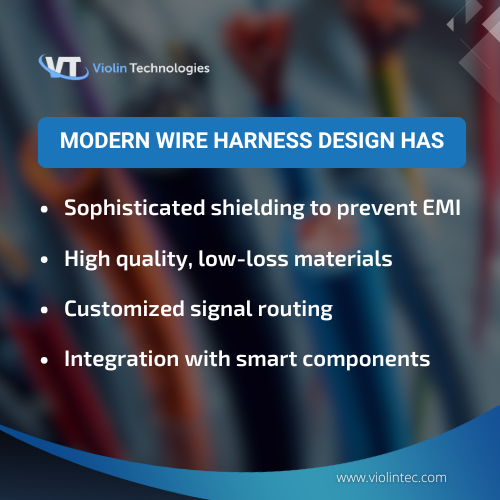That’s exactly why today’s industries from automotive to aerospace to industrial automation are aggressively rethinking their wiring systems. What was once considered a simple network of bundled cables is now a highly engineered backbone of speed, stability, and signal integrity. And at the heart of this evolution lies the modern wire harness, quietly working behind the scenes to ensure devices, machines, and vehicles communicate instantly and flawlessly.
Let’s dive into why wire harnesses play such a crucial role in this transformation and how the industry is adapting to meet rising performance demands.
What we cover in this blog?
Why High-Speed Data Transmission Matters More Than Ever
Connectivity is no longer a premium feature; it’s a baseline of expectation.
Think about current trends:
- Cars are rolling down the roads, packed with ADAS sensors, cameras, navigation units, and infotainment systems.
- Factories rely on automation systems that must relay data in milliseconds.
- Medical devices require instant communication between sensors and processors.
- Consumer devices, from smart appliances to wearable tech, constantly exchange information.
All of these systems demand fast, stable, interference-free data flow. And if the wiring can’t keep up? Devices fail; safety systems lag, and user experiences crumble.
That’s why industries are leaning heavily on the Best Wire Harness Manufacturers in India, known for producing harnesses that don’t just carry electricity but carry information with precision and speed.
The Shift Toward High-Speed Harness Engineering
Traditionally, wire harnesses were built to manage power distribution. Today, they must also act as shielded, optimized pathways for high-frequency signals.
Here’s what modern harness design looks like:
1. Sophisticated Shielding to Prevent EMI
With multiple devices running simultaneously, electromagnetic interference becomes a silent enemy. Manufacturers now use:
- Foil shields
- Braided copper shields
- Multi-layer EMI barriers
These ensure that sensitive data signals aren’t distorted during transmission.
2. High-Quality, Low-Loss Materials
To ensure speed and integrity, cable materials must minimize resistance and signal loss.
This includes:
- High-grade copper
- Silver-plated conductors for improved conductivity
- Precision extrusion for insulation
This is particularly pivotal in industries like aerospace and defense, where every microsecond of delay matters.
3. Customized Signal Routing
Off-the-shelf wiring solutions rarely work in high-speed applications. That’s why many brands partner with Custom Cable Manufacturers in India to build harnesses tailored to their device layout, connectors, and environmental conditions.
Customization ensures:
- Optimal path lengths
- Reduced crosstalk
- Predictable signal behavior
A one-size-fits-all harness can’t deliver that.
4. Integration with Smart Components
Some modern harnesses even integrate:
- Data filters
- Microchips
- Diagnostic modules
This transforms the harness into an intelligent network rather than just a physical bundle of wires.

Industry Demands Driving This Evolution
Automotive
Electric and autonomous vehicles require massive, high-speed data exchange.
Examples:
- Cameras transmitting real-time visuals
- Radar and LiDAR data
- Over-the-air software updates
- Battery management communication
Any latency in these systems could be disastrous. So, manufacturers must increasingly collaborate with the Best Quality Contract Manufacturing Partners in the USA to build specialized harnesses that meet strict safety and speed requirements.
Healthcare
In medical equipment, accuracy is everything.
Ultrasound machines, patient monitors, ventilators, and robotic surgical tools depend on ultra-stable data flow. Slow or distorted signals could compromise patient safety, making high-quality wiring essential.
Industrial Automation
Smart factories run on sensors, robots, PLCs, and real-time control systems. Reliability and speed are non-negotiable. Even a tiny disruption can halt production.
That’s why many manufacturers now demand harnesses with:
- Ruggedized materials
- High-frequency compatibility
- Robust shielding
Telecommunications & Data Centers
With cloud computing, 5G, and the expansion of IoT, data centers have become the nerve centers of the digital world. The wiring used must handle extreme data loads and temperature while remaining highly efficient.
Challenges in Designing High-Speed Harnesses
Despite advancements, high-speed harness engineering isn’t without its hurdles.
1. Space Constraints
Devices are shrinking, but the need for more data channels is increasing. Designing compact harnesses that don’t compromise performance is a major challenge.
2. Greater Transparency for Customers
High-speed signals generate heat. Managing heat without degradation requires innovative insulation and design techniques.
3. Signal Integrity in Harsh Environments
From vehicle vibration to industrial moisture and dust, harnesses must endure tough conditions without affecting data flow.
4. Rapid Technological Shifts
What was considered “high-speed” three years ago is now outdated. Manufacturers must constantly upgrade processes to meet new expectations.
Why Choosing the Right Manufacturing Partner Matters
If there’s one thing industry leaders agree on, it’s this: the difference between an average harness and a high-performance harness can define the reliability of the entire system.
Businesses now look for partners who offer:
- Precision engineering
- Industry certifications
- Testing across frequencies, temperatures, and environmental stresses
- Custom design expertise
- Scalable manufacturing
This explains the growing demand for the Best Wire Harness Manufacturers in the USA who can support both prototyping and mass production.
Partnering with the right team can dramatically improve product performance, reduce maintenance issues, and accelerate time-to-market.
Looking Ahead: The Future of High-Speed Connectivity
As we step deeper into an era powered by AI, EVs, IoT, robotics, and automation, the demand for high-speed data infrastructure will only intensify. Wire harnesses may not always be visible, but they remain one of the most critical components powering this digital revolution.
We’ll see trends like:
- Lightweight, ultra-thin harnesses
- Fiber-optic integration
- Harnesses supporting 10Gbps+ communication
- Eco-friendly insulation materials
- Embedded smart diagnostics
The future is fast, connected, and data-driven, and wire harnesses will be at the center of it all.
Final Thoughts
Modern innovations are pushing the boundaries of what wiring can do, and the progress is nothing short of excitement. Whether you’re building smart devices, electric vehicles, industrial machines, or next-gen medical equipment, high-speed data transmission is no longer optional; it’s the foundation of functionality. And choosing the right wire harness manufacturing partner can make or break your product’s performance.

